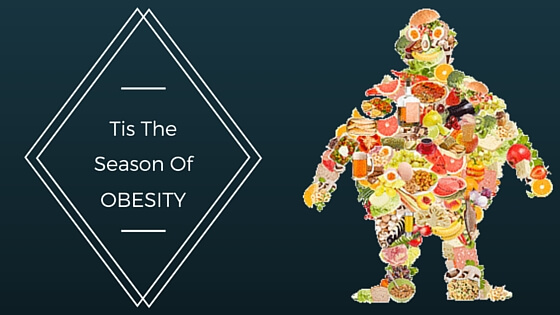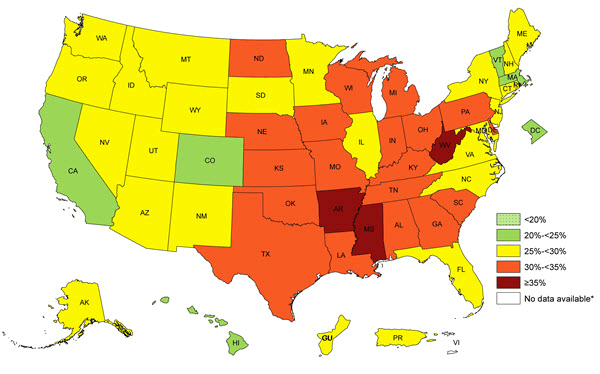Tis the Season of Obesity
Posted by Emily Thompson on Sep 1st 2020

Despite the efforts of medical, social, and government officials, even First Lady Michelle Obama, the number of obese Americans is shockingly still increasing. A staggering 38 percent of American adults are obese, up from what was already an alarming rate of 30 percent in 1999.
On Thursday the Centers for Disease Control and Prevention (CDC) National Center for Health Statistics (NCHS) released the results of its examination of data from the National Health and Nutrition Examination Surveys. The authors found: “More than one-third of adults and 17% of youth in the United States were obese in 2011–2014.”
While this news is undeniably discouraging, the timing should be a reminder to all in the pharmacy that the holidays, the time of year that challenges even the most health and nutrition conscious, are just days ahead. It is time to double down on gently reminding all of our patients and customers that seconds of mashed potatoes or our favorite pie can have serious lasting negative effects.
The Holidays and Weight Gain
There has been some controversy over just how important it is to count calories during the holiday season. Urban myth, likely backed by clever marketing for gym subscriptions, has it that we all can expect to add on at least five pounds between Thanksgiving and New Years Day. Research has disproven this commonly held belief, but revealed something much more insidious.
About the same time the CDC found that about a third of Americans were obese, the New England Journal of Medicine published in March 2000, “A Prospective Study of Holiday Weight Gain.” The researchers discovered that, “On average, weight gain during the 6-week winter period from Thanksgiving through New Year averaged only 0.37 kg (3/4 lb). However, weight gain was greater among individuals who were overweight or obese, and 14% gained >2.3 kg (5 lb). In addition, among the entire population, weight gain during the 6-week holiday season explained 51% of annual weight gain.
While it may not be surprising that obese individuals gain more weight than others during the holidays, what the above findings mean for all of us is that pounds added over the holidays are not easily shed over the year, if ever. Thursday’s NCHS obesity data is at the least an indicator that no matter a person’s current weight, over-eating during the holidays has fundamental consequences.
Think of it in simple terms of weight and height. If you are a 5’9” man, weighing 160 lbs., and you gain a pound over the holidays, two for the year, you will be “overweight’ in five years. Because we also know the heavier a person is the more weight is gained over the holidays, that unless balance in diet and exercise is achieved, obesity and all the related life-threatening conditions are a no-kidding possibility.
So what can you do in the pharmacy?
Talk, and do so with care. Your approach is significant in that, when done well and without bias, there are positive outcomes. Obesity is a disease, and needs to be respected as one.
In a 2014 National Institutes of Health study, researchers found that if a health care professional speaks with an overweight or obese patient about their need to focus on losing weight, their chances of losing 5 percent of their body weight over 12 months double, and their chances more than double for losing 10 percent.
If a health care professional delivers services, including good advice, that are perceived to carry a negative anti-obesity bias, an overweight patient may actually avoid seeking medical care or assistance in reducing their weight or addressing other medical conditions. And it is no wonder.
In a survey of 400 doctors, one third said, “They associated obesity with noncompliance, hostility, dishonesty, and poor hygiene.” In a survey of overweight and obese women, more than two-thirds said they had experienced bias against them from medical professionals, with more than half saying this experience occurred more than once.
What is even worse, an interaction perceived as biased, puts a patient under stress, triggering the production of cortisol, the fight or flight hormone. The result for some, especially women suffering from obesity, can be binge eating.
What’s New
1. Aspirin
Researchers at Newcastle University and the University of Leeds, UK, conducting a 10-year study found that obese patients who took a regular dose of aspirin daily reduced their risk of cancers in the womb and colon. These cancers are more common among obese patients than others.
2. Saxenda
The Food and Drug Administration (FDA) approved Saxenda (liraglutide [rDNA origin]), to be used in conjunction with a low-calorie meal plan and exercise. The FDA noted, “Saxenda is a glucagon-like peptide-1 (GLP-1) receptor agonist and should not be used in combination with any other drug belonging to this class, including Victoza, a treatment for type 2 diabetes.” Saxenda was not approved for use in the treatment of type 2 diabetes. The risks include: pancreatitis, gallbladder disease, renal impairment, suicidal thoughts, and an elevated resting heart rate.
3. Vyvanse
The FDA expanded the approved use of Vyvanse (lisdexamfetamine dimesylate) for the treatment of binge-eating disorder in adults, the first medication approved to treat the condition. The risks include: psychiatric problems, heart complications, stroke, and heart attack. Of note, the FDA first approved Vyvanse to treat attention deficit hyperactivity disorder.
Fast Facts
- About 60% of Americans are overweight or obese.
- Obesity alone is the cause of 200,000 deaths every year.
- Treating obesity costs up to $210 billion annually.
- Obesity is mostprevalent in middle age adults, 40-59 years old (39.5 percent).
- 17 percent of children and adolescents aged 2-19 years are obese.
- No U.S. state has an obesity rate of less than 20 percent.
- Only 5 states and the District of Columbia have an obesity rate under 25%.
- Arkansas, Mississippi and West Virginia have the highest obesity rate of least 35%.
Prevalence of Self-Reported Obesity Among U.S. Adults by State and Territory, 2014 - CDC

